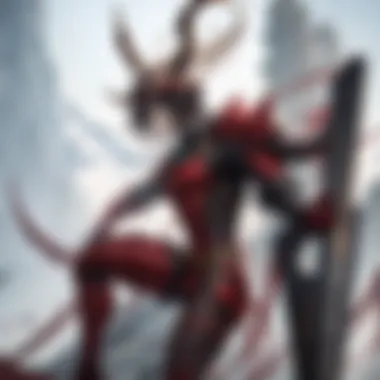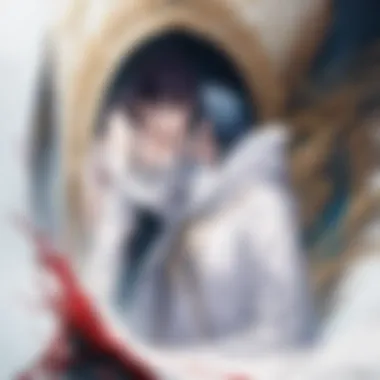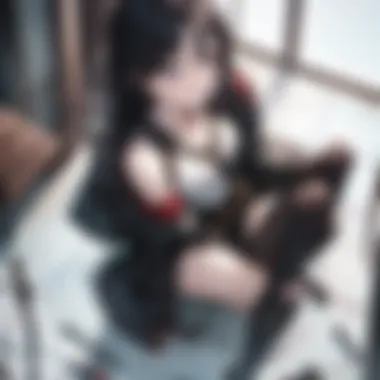Unveiling the Intricacies of 'Shingeki no Kyojin': A Comprehensive Analysis


Introduction to the Series
'Shingeki no Kyojin,' known internationally as 'Attack on Titan,' is a Japanese manga series written and illustrated by Hajime Isayama. The series falls within the action-fantasy genre, blending elements of dark fantasy and post-apocalyptic themes. Initially serialized in September 2009, 'Shingeki no Kyojin' gained immense popularity for its intense storyline and unconventional characters. As one of the best-selling manga series, it has amassed a massive following worldwide. Fans of intricate world-building and complex narratives gravitate towards this series.
Staff and Cast Details
The brilliance of 'Shingeki no Kyojin' extends beyond the captivating storyline to the talented individuals who bring it to life. With Tetsurō Araki as the director and Yasuko Kobayashi as the writer, the anime adaptation astounds with its rich animation and gripping plot development. The key animators and designers, like Kyoji Asano and Ayumi Yamada, infuse the series with visually stunning elements. The voice cast, including Yuki Kaji as Eren Yeager and Yui Ishikawa as Mikasa Ackerman, delivers remarkable performances that intensify the emotional depth of the characters. This synergy of creative minds forms the backbone of the series' success.
Theme Music Analysis
The theme music of 'Shingeki no Kyojin' amplifies the narrative's impact, drawing viewers deeper into the story's emotional core. Composed by Hiroyuki Sawano, the opening and ending songs encapsulate the series' essence with their evocative melodies. Linked Horizon's iconic 'Guren no Yumiya' perfectly captures the fierce spirit of humanity's struggle, while the closing theme 'great escape' by cinema staff echoes the melancholy and defiance prevalent throughout the series. The thematic convergence of the music with the storyline accentuates the series' intensity and emotional resonance.
Plot Summary and Analysis
Within the labyrinthine plot of 'Shingeki no Kyojin' lie intricate twists and profound character developments that keep audiences on the edge of their seats. The saga follows humanity's battle against monstrous Titans, intertwining complex themes of survival, freedom, and betrayal. From Eren Yeager's quest for retribution to the mysteries surrounding the walls protecting mankind, each narrative arc unveils new layers of intrigue and uncertainty. Isayama's narrative craftsmanship shines through in the series' seamless blend of action, suspense, and moral dilemmas, leaving viewers pondering the intricacies of power and humanity.
Reception and Impact
'Shingeki no Kyojin' has not only garnered critical acclaim but also left an indelible mark on the anime landscape, inspiring a fervent global fanbase. The series has received accolades from both critics and fans, commending its bold storytelling and nuanced character portrayals. Its cultural impact reflects in merchandise sales, fan theories, and cosplay events that celebrate the enduring legacy of 'Shingeki no Kyojin' in popular culture. As a trailblazer in its genre, the series sets a high standard for future animemanga to emulate, solidifying its position as a cornerstone of contemporary storytelling.
Introduction
In the realm of anime analysis, delving into the multifaceted world of 'Shingeki no Kyojin' unveils a tapestry rich in narrative dimensions. From the intricate character developments to the underlying socio-political themes, this anime captivates enthusiasts with its compelling storytelling. This section serves as a gateway to the detailed exploration of pivotal elements that define 'Shingeki no Kyojin'.
Overview of 'Shingeki no Kyojin'
Premise and Setting
Embarking on a journey through the dystopian world of 'Shingeki no Kyojin,' the premise and setting serve as foundational pillars that underpin the storyline's intensity. The backdrop of a civilization besieged by giant humanoid creatures sets the tone for a narrative marked by survival, betrayal, and relentless perseverance. This choice of premise and setting not only immerses viewers in a world fraught with danger but also offers a unique storytelling canvas that challenges conventional anime tropes.
Main Characters
Central to the allure of 'Shingeki no Kyojin' are its main characters, each woven with complexities and intrinsic motivations. Characters like Eren Yeager, Mikasa Ackerman, and Levi Ackerman command attention with their distinct personalities and contributions to the overarching narrative. Their evolution throughout the series not only shapes the plot but also delves into the depths of human resilience and vulnerability, making them pivotal components of the anime's success.
Genre and Themes


Exploring the genre and themes embedded within 'Shingeki no Kyojin' unravels layers of societal commentary and philosophical inquiries. The fusion of dark fantasy, action, and mystery genres crafts a compelling viewing experience that transcends traditional anime boundaries. Touching upon themes of power dynamics, societal stratification, and the eternal struggle between freedom and oppression, 'Shingeki no Kyojin' beckons viewers to ponder on profound existential questions.
Historical Context
Influence of World War
The narrative landscape of 'Shingeki no Kyojin' draws significant influence from the tumultuous epochs of historical conflicts, particularly World War scenarios. This thematic parallel not only adds depth to the storyline but also underscores the poignant reflections on human nature, warfare, and the consequences of monumental struggles. By intertwining historical motifs with a fictional narrative, the anime invites viewers to introspect on the echoes of the past reverberating in a fictional future.
Impact on Anime Industry
Popularity and Influence
The meteoric rise of 'Shingeki no Kyojin' within the anime sphere marks a paradigm shift in the industry's landscape, catapulting it to global acclaim. The anime's popularity transcends borders, captivating a diverse audience and sparking fervent discussions on its narrative intricacies. Its influence not only resonates with long-time anime enthusiasts but also reaches newcomers, breathing new life into the anime zeitgeist with its innovative storytelling approach.
Genre Evolution
By ushering in a new wave of narrative structuring and thematic exploration, 'Shingeki no Kyojin' emerges as a trailblazer in steering the evolution of anime genres. The seamless fusion of nuanced character portrayals, complex plotlines, and socio-political commentaries sets a benchmark for genre innovation. As the anime landscape diversifies, 'Shingeki no Kyojin' stands at the forefront, challenging norms and expanding the horizons of what anime can achieve.
Character Analysis
Character analysis plays a pivotal role in this comprehensive exploration of 'Shingeki no Kyojin'. By dissecting the intricate layers of each character, we gain profound insights into their motivations, struggles, and contributions to the storyline. Through a meticulous examination of Eren Yeager, Mikasa Ackerman, and Levi Ackerman, we unravel the complex web of emotions and decisions that shape the narrative of this acclaimed anime.
Eren Yeager
Eren Yeager stands as a central figure in 'Shingeki no Kyojin,' with his journey marked by profound development and unwavering motivations. The evolution of Eren's character, fueled by personal tragedies and a relentless pursuit of freedom, underscores the theme of resilience amidst adversity. His motivations, deeply rooted in a quest for justice and vengeance, drive the narrative forward with intensity and purpose, making him a compelling protagonist. However, Eren's unwavering convictions also lead to moral ambiguity, adding layers of complexity to his character that spark contemplation and debate among viewers.
Development and Motivations
Eren's development is characterized by a transformation from innocence to a hardened warrior, shaped by loss and trauma. His motivations, fueled by the desire to protect humanity and eradicate Titans, reveal a depth of emotion and conviction that resonates with audiences. The dichotomy of Eren's character, torn between compassion and ruthlessness, lends a poignant realism to his persona, making his development a critical aspect of the series' resonance with viewers.
Role in the Storyline
Eren's role in the storyline is integral, as he serves as a catalyst for transformation and conflict within the narrative. His decisions, often driven by personal vendettas and a steadfast determination to uncover the truth, propel the plot towards moments of revelation and consequence. Eren's complex role as both hero and anti-hero adds moral ambiguity and dimension to the overarching story, challenging conventional notions of heroism and sacrifice.
Mikasa Ackerman


Mikasa Ackerman's character exudes a blend of strength, vulnerability, and unwavering loyalty, creating a nuanced portrayal that defies stereotypes. Her complexities lie in her fierce dedication to protecting Eren, coupled with a struggle to reconcile her past traumas and identity.
Complexities and Relationships
Mikasa's complexities are evidenced in her intricate relationships, particularly her dynamic with Eren and her internal conflict between duty and personal fulfillment. Her unwavering loyalty and protective instincts toward Eren showcase a deep emotional bond that transcends mere friendship, adding depth and emotional resonance to their interactions. Mikasa's internal struggles and external strength make her a multifaceted character that enriches the narrative with layers of tension and introspection.
Levi Ackerman
Levi Ackerman, known for his unparalleled combat skills and stoic leadership, emerges as a pivotal figure in 'Shingeki no Kyojin,' embodying a blend of prowess and tragedy. His combat prowess, honed through years of experience and discipline, makes him a formidable force on the battlefield, instilling fear in enemies and respect in allies.
Combat Skills and Leadership
Levi's combat skills and leadership abilities set him apart as a strategic powerhouse, capable of outmaneuvering adversaries with precision and finesse. His strict adherence to principles of order and effectiveness in combat speaks to a leadership style rooted in pragmatism and a desire for efficiency. However, Levi's uncompromising nature and emotional reticence also isolate him from others, highlighting the personal sacrifices he makes in the name of duty and survival.
Plot Analysis
Major Story Arcs
- Battle of Trost:
Battle of Trost:
The Battle of Trost stands as a defining moment within the 'Shingeki no Kyojin' storyline, encapsulating the intense struggles and sacrifices of humanity against the titanic threat looming beyond the walls. This crucial arc showcases the characters' resilience, valor, and strategic acumen in the face of unparalleled adversity, mirroring real-world warfare dynamics. The Battle of Trost's significance lies in its portrayal of desperation, heroism, and tragedy, echoing poignant themes of survival and sacrifice amidst seemingly insurmountable odds. Its narrative impact resonates throughout the series, setting the stage for future developments and character growth.
- Clash of Titans:
Clash of Titans:
The Clash of Titans arc delves into the intricacies of titan conflict, uncovering hidden truths, betrayals, and revelations that redefine characters' perceptions and motivations. This pivotal arc introduces a new layer of complexity to the narrative, challenging established beliefs and alliances while unraveling the mysteries surrounding the titans' origins. With its high-stakes confrontations, ideological clashes, and personal vendettas, the Clash of Titans arc elevates the series' intensity and suspense, propelling both characters and audience into a whirlwind of uncertainty and intrigue.
- Return to Shiganshina:
Return to Shiganshina:
The Return to Shiganshina arc marks a significant turning point in 'Shingeki no Kyojin,' bringing the narrative full circle as characters confront their past, present, and future amidst the ruins of their hometown. This emotionally charged arc delves into themes of redemption, betrayal, and self-discovery, challenging characters to confront their inner demons and make difficult decisions that will shape the course of humanity's fate. With its blend of action-packed sequences, character revelations, and tragic resolutions, the Return to Shiganshina arc solidifies 'Shingeki no Kyojin's' position as a standout in the anime landscape, captivating audiences with its narrative depth and thematic richness.


Themes and Symbolism
- Freedom vs. Oppression:
Freedom vs. Oppression:
The dichotomy between freedom and oppression lies at the heart of 'Shingeki no Kyojin,' underscoring the characters' relentless struggle for liberation in a world rife with tyranny and injustice. This thematic undercurrent permeates the narrative, driving characters to question their values, loyalties, and convictions in pursuit of a brighter future. The juxtaposition of personal freedom against systemic oppression adds layers of moral complexity and philosophical depth to the series, resonating with audiences on a visceral and intellectual level.
- Power and Corruption:
Power and Corruption:
Power and Corruption serve as intertwined themes within 'Shingeki no Kyojin,' illuminating the dark underbelly of authority and governance within the walls. As characters navigate political intrigue, moral dilemmas, and ethical quandaries, the series unveils the corrupting influence of power and the struggles inherent in maintaining integrity amid temptation. Through nuanced character interactions and moral quandaries, 'Shingeki no Kyojin' explores the fragility of power structures and the inherent risks of succumbing to corruption, inviting audiences to reflect on the nature of power and its impact on individuals and society.
Critical Reception
Critical Reception holds immense significance within the context of this article as it provides a comprehensive assessment of how 'Shingeki no Kyojin' has been received by audiences and critics alike. Evaluating the receptions of each season allows for a deeper understanding of the show's impact and quality. By dissecting critiques, praises, and analyses, readers can gain insights into the strengths and weaknesses of the series. The critical reception section serves as a crucial guide for viewers interested in understanding the broader reception and critical viewpoints surrounding 'Shingeki no Kyojin'. It helps in shaping perspectives and encourages further exploration of the anime's various elements and intricacies.
Review of Seasons
Season 1: The Beginning
Season 1: The Beginning sets the foundation for the entire series, introducing viewers to the post-apocalyptic world where humanity struggles against giant humanoid creatures known as Titans. This season effectively establishes the central conflict, character dynamics, and thematic depth that propel the narrative forward. The key characteristic of Season 1 lies in its ability to create a sense of suspense, mystery, and intrigue, captivating the audience right from the start. The strategic pacing and character development in Season 1 make it a pivotal choice for in-depth analysis as it lays the groundwork for the complex themes explored throughout the series.
Season 2: Revelations
Season 2: Revelations delves deeper into the mysteries surrounding the Titans, uncovering hidden truths and expanding the lore of the 'Shingeki no Kyojin' universe. This season offers significant revelations about the origins of the Titans, character backstories, and the political dynamics within the story. The key characteristic of Season 2 is its ability to subvert expectations and introduce new layers of complexity to the narrative. While some may find the slower pace a disadvantage, the depth of storytelling and character exploration in Season 2 adds a richness that enhances the overall storyline.
Season 3: Paradis Island
Season 3: Paradis Island shifts the focus to internal conflicts within the walls, exploring themes of power struggles, morality, and betrayal. This season delves into the complexities of human nature and the consequences of past actions, adding layers of political intrigue and moral ambiguity to the narrative. The key characteristic of Season 3 lies in its profound character development and thematic depth, challenging viewers to question the complexities of right and wrong. While the slower pacing may deter some viewers, the depth of storytelling and thematic exploration in Season 3 offers a compelling analysis of human nature within the 'Shingeki no Kyojin' world.
Cultural Impact
Global Fandom
The Global Fandom surrounding 'Shingeki no Kyojin' showcases the immense influence and reach of the series on a global scale. The passionate fanbase, diverse fan theories, and online discourse contribute to a rich community that engages deeply with the narrative, characters, and themes of the show. The key characteristic of the Global Fandom lies in its ability to foster international connections and discussions, transcending cultural boundaries to unite fans worldwide. While the intensity of fandom may lead to debates and disagreements, the Global Fandom's shared love for 'Shingeki no Kyojin' emphasizes the series' universal appeal and enduring impact.
Memes and Merchandise
The Memes and Merchandise of 'Shingeki no Kyojin' reflect the cultural phenomenon that the series has become, extending its presence beyond the screen into everyday life. Memes based on iconic scenes, characters, and catchphrases from the show resonate with fans, creating a shared language and sense of humor within the community. The key characteristic of Memes and Merchandise is their ability to enhance the fan experience, providing avenues for creative expression and connection through shared references. While an oversaturation of memes and merchandise may dilute the original content, the strategic integration of these elements adds a new layer of engagement and cultural relevance to the 'Shingeki no Kyojin' experience.















